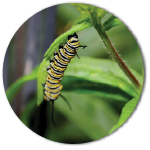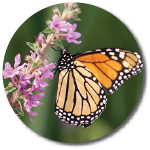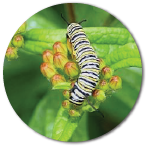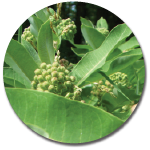"What do you like to eat for breakfast? I like to eat crayfish, bugs and little fish I find near the bottom of the Creek where it's nice and cool! A clean Creek bottom makes my breakfast yummy!"


Monarch Butterfly
The Lake Nipissing watershed is a critical area for several species at risk or of special concern - including the Monarch butterfly.
This patch of common milkweed (Asclepias syriaca) alongside Chippewa Creek is the perfect habitat for the Monarch. Milkweed is a favoured food plant for the earlier larval life stage of Monarch butterflies, and there are also many other nectar sources, sunshine and shelter for them here.
In their larval stage, the Monarch butterfly feeds only on plants in the milkweed family (Asclepiadaceae). Common milkweed bears pink to lavender flower clusters from June through August; in late summer, it develops warty seedpods-the most striking of the milkweed pods. You may be lucky enough to see these horn-shaped pods near the tops of the plants at that time of year.
Adult butterflies searching for nectar are most attracted to orange, purple, yellow or red blossoms that are flat-topped or clustered and have short flower tubes. These tubes allow the butterfly to reach the nectar with its snout (proboscis). Favourite flowers are mainly in the Asteracease (sunflower and daisy) family of plants.
The nearby trees and shrubs act as a wind barrier that protects butterflies while they’re laying their eggs or feeding on nectar.

A Species of Concern
Ontario: Destruction of common milkweed, land clearing and weed control.


Species at Risk in Nipissing (as of 2012)
What about the air we breathe? Leaves filter the air by removing dust and other air pollutants such as ozone, carbon monoxide and sulfur dioxide. Trees also help us adapt to climate change impacts by taking in carbon dioxide and releasing oxygen, helping to reduce greenhouse gas emissions.
Trees provide a windbreak to protect people, pets and buildings; the more compact the leaves or group of trees, the greater the benefits of the windbreak.
Economically, trees play an important role in energy cost savings and increasing property value. Summer air conditioning and winter heating costs are lower in a tree-shaded home. When these individual savings are added up for a community, they reduce the community’s need for expensive non-renewable forms of energy, like oil and gas. Trees increase in value from the time they are planted until they mature and add to the value of a home much like having an updated kitchen or bath.
Research shows that trees play a role in health and wellness. In a series of studies, scientists found that when people spend time in more natural surroundings — forests, parks and other places with plenty of trees — their immune system is boosted. Scientists chalk it up to phytoncides, airborne chemicals that plants emit to protect them from rotting and insects and which also seem to benefit human health.



